September 1, 2009
The Proud Palm Tree
On a peninsula in Southeast Asia lies a country once called “Kampuchea,” meaning “The Land of Gold.” During the colonial period the French called it “Cambodge,” a name that later evolved into “Cambodia.” There are a lot of palm trees in most farming fields in Cambodia. One day our Training of Timothys team was returning from a seminar on unity in Kompong Thom. On the way back to Phnom Penh my team asked me, “Let’s stop for a while to shoot a rabbit (i.e., find a rest room).” So I stopped the car and we went to “shoot a rabbit” or “see a man about a dog,” and I noticed a palm tree with another kind of tree growing on it. That was interesting! The tree was called Chrey in Cambodian.
Some Cambodian farmers consider the bamboo and palm tree to be husband and wife. The palm tree is very useful. It can be used for building houses, barns, boats, and farming tools. Its leaves can be used to thatch roofs, make hats, mats, containers for rice crops, etc. Its juice can produce sugar, its fruit can be cooked as food, and when it ripens the palm can be used to make Akor and other kinds of cake.
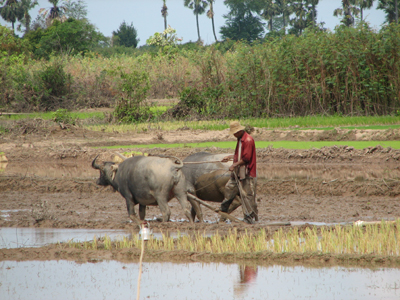
Photo by Chiv Taing
So the palm tree is very useful from root to leaves, just as is the bamboo. Its trunk is strong and hard. It has sturdy roots. Storms only rarely can cause a palm tree to fall. Its leaves look dark green all year round, similar to a pine tree or Christmas tree. It does not change color as the seasons pass. That is why owners of some five-star hotels and other buildings in Phnom Penh plant palm trees in their yards as decorations. They not only add beauty to the hotel, but also invite people caught up in a rat-race society to think about the peaceful countryside lives of Cambodian farmers. In the 1998 election one political party chose the palm tree as its emblem. Perhaps they thought they could focus the attention of the Khmer people on the strength of the tree and the unchanging evergreen color of its leaves, and so win people’s hearts and votes.
I also agreed with that idea! Most Cambodians artist express similar feelings by including palm trees in their paintings of countryside scenery. The palm tree is a strong and useful plant in Cambodia. It can stand firm whether in flood or in storm or in dry season, and it also stands symbolically as a national tree.
But the palm tree will die if there is some dirt on it, even though it is so proud with its beauty and its strength. If the farmer does not come to cut the leaves and they stay attached, some dirt may accumulate where they attach to the trunk. Birds will drop into this dirt on the palm tree their stools carrying seeds of fruits they have eaten. When the rainy season comes, these small seeds will germinate and grow. At first they look too small to bother the tall palm tree. Maybe the palm even looks proud of having two kinds of tree growing together.
But as the years fly by the other tree grows bigger and bigger. Eventually the palm can’t get enough of the nutrients that its roots absorb from the ground because the other tree sucks them all away. The palm tree then becomes malnourished, and before long dies.
When we had World Vision staff retreat in Siem Reap two years ago we visited a ruined temple. I noticed that some of the temple walls had been destroyed by the same kind of tree I saw growing on the palm tree. Its root had split the stones from sticking close together. As long as the stones stayed close together the wall looked good, and the beauty of each relief it bore vividly reflected the civilization of the Khmer Empire. In order to save the temple from falling apart the Ministry of Tourism had workers cut the root of the tree away. Most of the ruin was destroyed by a root that grew between the stones of the temple. These trees had flourished during the long years of the civil war when no visitors came to see the temple. Cambodia was cut off from the world for nearly two decades. Neither local nor overseas visitors came to the temples during the time of the killing fields. So not only were people killed during that time, even the stones were badly damaged.
It reminded me of the relationship that God and his people once enjoyed. In the beginning man and God were close companions, but after the fall of Adam and Eve, sin entered this world and separated man from his creator. For the wages of sin is death. In order to fix the broken relationship sin must be dealt with first. It is like the stone wall at Angkor Wat. To save it from destruction they need to send some agent from the Ministry of Tourism to cut the root. When it first started growing the root looked very small, but as time went by it grew bigger and bigger. The longer it stayed the worse the damage it caused to the relief.
Sin at first starts very small, but as time passes its results grow worse and worse. Unrepented sin will ruin a relationship. As Christians please remember the lesson from the palm tree. Don’t be proud that we are strong, that we the palm tree are the symbol of the country—the chosen race or kin, and that they use us to decorate five-star hotels. Don’t be thrilled with the beauty and honor that we are given. If we forget to allow garden keeper to take away our old leaves we will become dirty, or birds will drop something on us. As an English saying reminds us, “We cannot stop birds from flying over our heads, but we can stop them from building their nests on our heads.”
We have to confess our sins to God. But if we confess our sins to God, he will keep his promise and do what is right: he will forgive us our sins and purify us from all our wrongdoing.[2] If we allow sin grow bigger and bigger we can never come the presence of the Lord and we will perish like a palm tree.
The same can happen in the relationships between friends and churches if we allow sins to grow between us. Like the stone wall at Angkor Wat, our relationship will fall apart. Beware of roots that start to grow between the stones that the builder originally placed close together. When the stones remain close together, they become the image of the four faces at Bayon or Apsara, and they look beautiful. But when tree roots grow in between, the original shape with its beauty and meaning is lost. Not only does it look ugly, but the whole temple may fall as well. Make sure you cut away the roots.
My friends, Jesus wants to fix the broken relationship with all humankind. God and man used to have a very close relationship. But sin separated us from God, and caused that relationship to break down. Because the sacred relationship between God and man broke, all other types of relationships have turned sour as well. Relationships between husband and wife, children and parents, brothers and sisters, nation and nation, race and race, etc., became spoiled and turned into in a mess. Why? It caused by SIN. But people, races, and societies can live in harmony if they allow Jesus cut off the root of sin. He is the only name that can save mankind.[3] He is the farmer who can clean the palm tree to keep it from being destroying by an invading plant. He is the agent from the Ministry of Tourism who can dig out the roots growing between stones of the ruin.
Conclusion:
- Palm trees can live long and stay strong if they have no other tree growing in their stem.
- Christians can stand strong in their faith if they don’t allow sin to grow bigger and bigger in their lives.
- Stones in old ruins can still look beautiful if they stay close to the original place where they were put.
- All kinds of relationships can be in harmony if sin is dealt with first.
[1]Uon Seila, “Bamboo,” Honeycomb 2/2 (April 2002): 10–15.
[2]1 John 1:9.
[3]Acts 4:12.
Written by: Cambodianchristian.Com
Trackback URL: http://www.cambodianchristian.com/article/wp-trackback.php?p=185
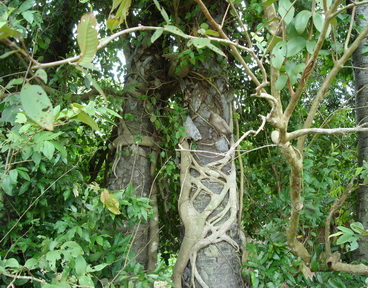
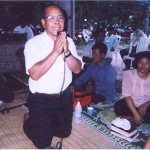



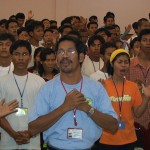
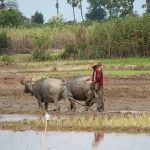
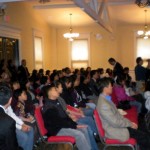
Hom
November 27, 2009 at 3:13 pm
My understanding is: Cambodia is the only place where the
sweet palm tree grows?
I think it is very unique what the palm tree represents:
.It represent uprightness
.An upright person is like a palm tree
Tamar, Judahs’ daughter in law was an ‘upright’ person.
Her name mean: Upright, an upright palm tree!
Cambodians, it’s time we start walking in our uprightness
before God and man. Why should we be destroy when we
can receive the ’sweetness’ of God’s forgiveness through
his son Yeshua our Messiah.
Blessed be Father God of the Universe who has planted
an upright palm trees in the midst of Cambodia for an
example that we can be an upright people for his glorious
kingdom on earth.
Hom